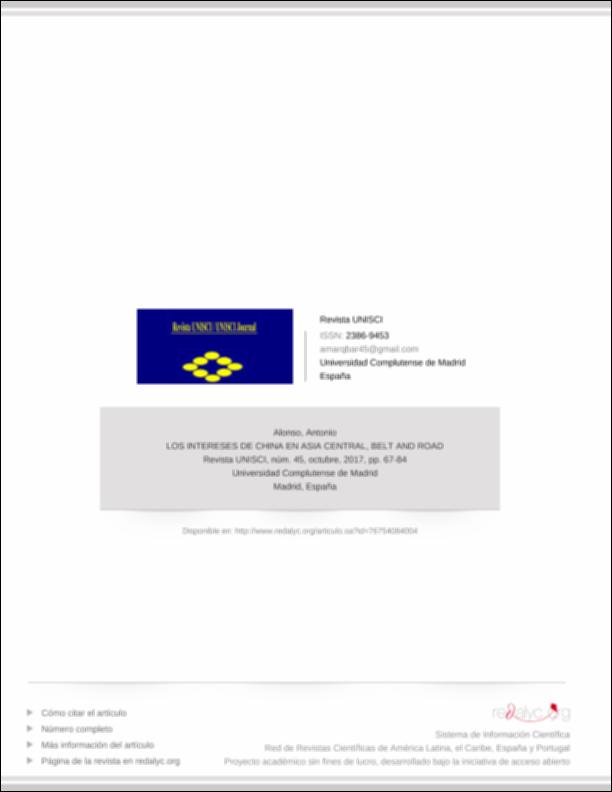Please use this identifier to cite or link to this item:
http://hdl.handle.net/10637/15323Los intereses de China en Asia Central, Belt and Road
| Title: | Los intereses de China en Asia Central, Belt and Road China´s Interests in Central Asia, Belt and Road |
| Authors : | Alonso Marcos, Antonio |
| Keywords: | Nueva Ruta de la Seda; Belt and Road; Asia Central; China; Rusia; Xi Jinping |
| Publisher: | Universidad Complutense de Madrid |
| Citation: | Alonso Marcos, Antonio. Los intereses de China en Asia Central, Belt and Road. Revista: UNISCI. DOI: 10.5209/RUNI.57284 |
| Abstract: | El interés de China por Asia Central ha recibido un nuevo impulso con la puesta en marcha de la iniciativa “One Belt, One Road”, rebautizada como “Belt and Road Initiative”, pero más conocida como la Nueva Ruta de la Seda. Gracias a la inversión en infraestructuras, China romperá su secula aislamiento y pondrá sus productos en el mercado global con mayor facilidad a partir de ahora por tierra y por mar. Aquí aparece inmediatamente la pregunta acerca de unas hipotéticas segundas intenciones –de influencia geopolítica— del gigante asiático sobre los países afectados por las nuevas
rutas (países de tránsito o destino final). El artículo trata de responder a las siguientes cuestiones: La República Popular China, ¿pretende sólo reactivar su mercado laboral interior, disminuir sus sobrecapacidades industriales y potenciar sus exportaciones? ¿Llega a su fin la globalización o se entra en una nueva fase de interconectividad? ¿Cómo afecta esto a las relaciones entre Rusia y China en la región centroasiática? China´s interests in Central Asia were propelled, with the launching of the initiative “One Belt, One Road”, renamed as “The Belt and Road Initiative”, better known as the New Silk Road. Thanks to the infrastructure investment China will become interconnected with other regions of the world, breaking up its secular isolation and will send its products to the global market more easily by land and sea. One principal question in this revolutionary change has to do with China´s hypothetical second intentions of geopolitical influence on the countries affected by the new routes (countries of transit or final destination). The article tries to answer the following questions: Does the People's Republic of China aim only to revive its internal labour market, reduce its industrial overcapacity and boost its exports? Is globalization coming to an end or is it entering a new phase of interconnectivity? How does this affect the relations between Russia and China in the Asian region? |
| Description: | Este artículo está disponible en la siguiente URL: Disponible en: http://www.redalyc.org/articulo.oa?id=76754084004 |
| URI: | http://hdl.handle.net/10637/15323 |
| Rights : | http://creativecommons.org/licenses/by/4.0/deed.es |
| ISSN: | 2386-9453 |
| Issue Date: | Oct-2017 |
| Center : | Universidad San Pablo-CEU |
| Appears in Collections: | Facultad de Derecho |
Items in DSpace are protected by copyright, with all rights reserved, unless otherwise indicated.


